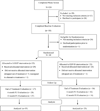The Adolescent Behavioral Activation Program: Adapting Behavioral Activation as a Treatment for Depression in Adolescence
- PMID: 25602170
- PMCID: PMC6107350
- DOI: 10.1080/15374416.2014.979933
The Adolescent Behavioral Activation Program: Adapting Behavioral Activation as a Treatment for Depression in Adolescence
Abstract
This study aimed to examine implementation feasibility and initial treatment outcomes of a behavioral activation (BA) based treatment for adolescent depression, the Adolescent Behavioral Activation Program (A-BAP). A randomized, controlled trial was conducted with 60 clinically referred adolescents with a depressive disorder who were randomized to receive either 14 sessions of A-BAP or uncontrolled evidenced-based practice for depression. The urban sample was 64% female, predominantly Non-Hispanic White (67%), and had an average age of 14.9 years. Measures of depression, global functioning, activation, and avoidance were obtained through clinical interviews and/or through parent and adolescent self-report at preintervention and end of intervention. Intent-to-treat linear mixed effects modeling and logistic regression analysis revealed that both conditions produced statistically significant improvement from pretreatment to end of treatment in depression, global functioning, and activation and avoidance. There were no significant differences across treatment conditions. These findings provide the first step in establishing the efficacy of BA as a treatment for adolescent depression and support the need for ongoing research on BA as a way to enhance the strategies available for treatment of depression in this population.
Figures
References
-
- Angold A, Costello EJ, Messer SC, Pickles A, Winder F, Silver D. Development of a short questionnaire for use in epidemiological studies of depression in children and adolescents. International Journal of Methods in Psychiatric Research. 1995;5:237–249.
-
- Angold A, Erkanli A, Silberg J, Eaves L, Costello EJ. Depression scale scores in 8–17-year-olds: effects of age and gender. Journal of Child Psychology and Psychiatry. 2002;43(8):1052–1063. - PubMed
-
- Atkins DC. Using multilevel models to analyze couple and family treatment data: basic and advanced issues. Journal of Family Psychology. 2005;19(1):98–110. - PubMed
-
- Beck AT, Rush JA, Shaw BF, Emery G. Cognitive therapy of depression. New York: Guilford; 1979.
-
- Brent DA, Poling K. Cognitive therapy treatment manual for depressed and suicidal youth. Pittsburgh, PA: University of Pittsburgh Health System Services for Teens At Risk; 1997.
Publication types
MeSH terms
Grants and funding
LinkOut - more resources
Full Text Sources
Other Literature Sources
Medical



